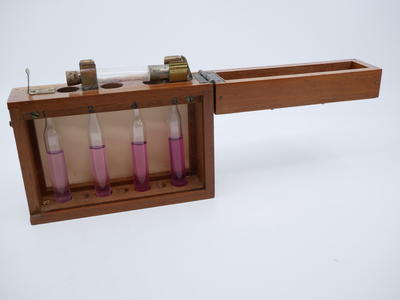K.B.B. "Uviometer" No 120
Maker
Kelvin Bottomley & Baird Ltd. (estab. 1913, closed 1947)
Date
Circa 1930-Circa 1940
Description
A "K.B.B. Uviometer", (incomplete) used to measure the strength of ultra-violet radiation.
The instrument comprises a mahogany wooden box with a lift-up lid under which are clamps to hold a tube (missing) and a lower section with a sliding wooden panel covering four glass phials containing pink fluid, graded from pale to deep in colour. Phials are backed by white plate which forms part of back of box. Broken "glow tube" included but does not belong.
Ultraviolet (UV) radiation is undetectable by the human eye, although, when it falls on certain materials, it may cause them to fluoresce—i.e., emit electromagnetic radiation of lower energy, such as visible light.
Ultraviolet radiation can have positive effects on the human body. It stimulates the production of vitamin D in the skin and can be used as a therapeutic agent for such diseases as psoriasis. Because of its bactericidal capabilities at wavelengths of 260–280 nm, ultraviolet radiation is useful as both a research tool and a sterilizing technique.
See full details


Do you know something about this object?
Be the first to comment on this object record.